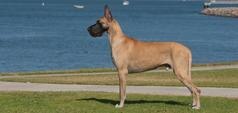
Improving Beagle Health: The Power of Health Testing

Beagle breeders have long recognized the value of using health screenings and genetic testing to improve the health of the breed. Thus, in 2004, the National Beagle Club (NBC) joined the Orthopedic Foundation for Animals’ Canine Health Information Center (CHIC) program — only three years after it was founded.
Currently, the CHIC program lists 10 health tests for Beagle, as recommended by NBC. Four of the 10 health tests are DNA tests for genetic conditions that tell breeders whether an individual Beagle is a carrier, clear or affected. Breeders can use this information to help evaluate breeding pairs to selectively breed dogs. Selective breeding ultimately can be used to help reduce disease prevalence.
Of the four genetic tests, the one for Musladin-Lueke syndrome (MLS) is required to earn CHIC health certification. The other tests are optional but recommended. This includes testing for Lafora epilepsy, factor VII (FVII) deficiency, and neonatal cerebellar cortical degeneration (NCDD).
“Breeders who step up to the plate to health test their dogs and then openly allow others to see the results of their
dogs’ health tests are helping to better the breed,” says Darlene Stewart, chair of the NBC Health and Genetics Committee.
MLS: A Required Health Test
When Musladin-Lueke syndrome was first reported in the 1970s in Beagles in the U.K. and Australia, the incidence rate was believed to be around 2 to 3 percent. The mysterious condition caused a variety of clinical signs, though dogs having the phenotypical characteristics of a broad skull with wide-set, slanted eyes and tiptoe walking were initially linked to the syndrome.
Nearly 40 years later, a genetic study began at the University of California-Davis led by Mark W. Neff, PhD, using the foundation work started by Beagle breeders Judith M. Musladin, MD, Anton C. Musladin, MD, and Ada T. Lueke. Dr. Neff discovered a missense founder mutation in the ADAMTSL2 gene and appropriately named the disorder Musladin-Lueke syndrome in their honour.
“The MLS mutation probably originated in the 1830s when the modern Beagle breed was being developed in Great Britain, as it is broadly distributed in dogs around the world,” says Dr. Neff.
The Musladins and Lueke started collecting pedigrees and case information on this type of Beagle in the early 1990s and described the disorder in their 1998 book, “The New Beagle.” They believed that MLS had an autosomal recessive inheritance, which proved to be true.
Beagle breeder Bev Davies-Fraser of Red Deer, Alberta, Canada, contributed DNA from several Beagles out of her Waskasoo bloodline to aid the research. “A request was posted on a Beagle email list searching for dogs with clinical signs that included tiptoe walking and wide-set eyes,” she says. “A female puppy out of my first litter whelped in 1992 walked on her toes. At the time, I didn’t think too much about it because my foundation sire did the same thing.”
In 2004, Davies-Fraser was mentoring a new Beagle breeder who had bred to a descendant of her foundation sire when she recognized the disorder in the 3-week-old puppies. “I knew right away these puppies had the unusual syndrome because of their eyes,” she says.
“I had the littermates to the dog my friend bred to, so I sent in DNA on these dogs and as many related dogs as I could along with their pedigrees, pictures and detailed descriptions,” says Davies-Fraser.
Likewise, Beagle owner Geraldine Aikman of Kennebunk, Maine, contributed DNA from her male Beagle “Jake.” “From the beginning when I got Jake at 6 months old, he had difficulty standing and would slip on wood floors,” she says. “When he laid down, his legs stuck out stiffly. He ran with a rocking gait, and his ears had a crease toward the back of the flap. He had a high-pitched bark and never bayed. He had seizures his entire life, and this is what caused his death at age 14.”
The University of California-Davis researchers used genome-wide association to identify the gene variant in Beagles for the connective tissue disorder that causes extensive fibrosis of the skin and joints. A more severe form of the disorder, geleophysic dysplasia, occurs in humans due to a mutation at the same gene locus. The DNA test for MLS in Beagles has been available since around 2010.
Lafora Epilepsy: An Optional But Recommended Health Test
One of the most severe forms of canine epilepsy, Lafora disease is a late-onset progressive myoclonic epilepsy occurring around 7 years of age often after dogs have been bred. Beagles, Miniature Wirehaired Dachshunds and Basset Hounds share the same mutation, a variable expansion of a dodecamer repeat sequence in the NHLRC1 (Epm2b) gene.
The autosomal recessive disorder results in near-absent expression and loss of function of the gene. Affected dogs are not able to make glycogen into the soluble, spherical form that can be stored in the cells and used by the brain for energy. Instead, insoluble glycogen accumulates within cells into large clumps called Lafora bodies. When these cells accumulate in nerve cells, the nerve cells malfunction and degenerate, causing neural problems that lead to seizures. A dog diagnosed with Lafora epilepsy may live to 10 to 14 years of age despite having the disease.
Lafora disease was first recognized in Miniature Wirehairs in the U.K. more than three decades ago. Researchers in the U.K. sent pedigree information and DNA from affected dogs to Berge A. Minassian, MD, formerly of The Hospital for Sick Children at the University of Toronto in Canada, who was studying a similar inherited, severe form of progressive myoclonic epilepsy in humans that occurs in late childhood or adolescence.
Dr. Minassian identified the Epm2b gene mutation for Lafora disease in Mini Wirehairs in 2005. The gene variant disables the gene from controlling laforin and from protecting tissues against carbohydrate accumulation. As the Lafora bodies accumulate, they have a neurotoxic effect on the central nervous system. When Lafora bodies amass within the nerve cells of the brain, the cells start to malfunction and degenerate causing twitching, jerking and sometimes seizures.
As the disease progresses, dogs experience other neurological problems, including dementia and difficulty walking. Besides brain tissue, Lafora bodies are found in muscles, skin, liver, and the heart. Lafora disease is a progressive myoclonic epilepsy and a glycogen metabolism disorder. The DNA test for Lafora epilepsy became available in 2017 for Beagles.
Factor VII Deficiency: An Optional But Recommended Health Test
Factor VII (FVII) deficiency, which can cause mild-to-moderate bleeding, was initially recognized in a colony of research Beagles. Investigators at the University of Pennsylvania School of Veterinary Medicine identified in 2006 the single missense G96E mutation in canine chromosome 22 that accounts for the autosomal recessive disorder.
FVII is a vitamin K-dependent glycoprotein synthesized in the liver and secreted into the circulation that has a pivotal role in the initiation of coagulation. A similar FVII deficiency occurs in humans, also causing mild-to-severe bleeding. In Beagles, the disorder has since been found to occur in companion dogs as well as research dogs.
“Reports of Beagles with FVII having bleeding issues are infrequent,” says Stewart of the NBC Health and Genetics Committee. “Many affected Beagles undergo surgery, dental cleanings and even cesarean sections without abnormal bleeding. Owners should be aware of their dog’s Factor VII status and should inform their veterinarian, but they should also be aware that having an affected Beagle does not mean automatic bleeding problems.”
The Factor VII DNA test enables the identification of carriers, clear dogs and affected dogs. At the time of the gene variant discovery, testing of a small sample of research Beagles found an allele frequency of 31 percent. Importantly, genetic testing enables breeders to selectively breed partners to reduce the incidence of FVII deficiency.
NCCD: An Optional But Recommended Health Test
In 2007, Jaqui Walton of York, North Yorkshire, England, was the breeder of a litter of seven puppies in which two puppies, a male and female, lay sprawled on their bellies unable to get their legs beneath them. Their swimming behaviour began at about 3 weeks of age when they were starting to move around.
“These puppies were not typical swimmers,” says Walton who breeds under the Vigor prefix. “They staggered around as though they were drunk. They would get their legs beneath them but would then reel off to either side and fall down.”
When the pups were 8 weeks of age, Walton had them examined by veterinary neurologists, who were not sure of the cause but thought the puppies had an incurable brain disease. Walton made the difficult decision to have the affected puppies euthanized.
“A necropsy was performed on the brain of the male puppy that was more severely affected, but the report came back inconclusive,” she says. “It was emotionally draining, and there were no answers.”
Then, the condition recurred in 2011 in a male puppy from a repeat breeding of the sire and dam. This time, Walton took the entire 4-week-old litter to veterinary neurologist Elsa Beltran, Ldo Vet, DipECVN, at the Animal Health Trust.
Dr. Beltran suspected an inherited degenerative cerebellar disease and agreed to investigate the problem. Again, Walton made the difficult decision to euthanize the affected puppy. Genome-wide mRNA sequencing — the first time this sequencing application was used to identify a candidate gene — was performed on the puppy’s DNA. Then, genotype analysis was done on the sire, dam, 10 clinically unaffected littermates, and the male puppy from the 2007 litter.
The discovery of an 8 bp deletion in the beta-III spectrin (SPTBN2) gene was found to cause the condition, now known as neonatal cerebellar cortical degeneration (NCCD). Humans have a similar condition involving three mutations in the SPTBN2 gene that is associated with the autosomal dominant condition spinocerebellar type 5 (SCA5). Beta-III spectrin is critical for Purkinje cell development, and an absence of this protein can lead to cell damage and neurological dysfunction seen in Beagle puppies. The DNA test to identify a Beagle’s inheritance of NCCD has been available since around 2012.
A rare disease, NCCD causes degeneration of cells in the brain’s cerebellum that are responsible for coordinated movement. As early as 2 to 3 weeks of age, the incoordination is noticeable. After a few weeks, the condition levels off. Affected dogs can live a normal life span, though they will have serious mobility issues throughout their lives.
Health Testing Success
Just as the National Beagle Club envisioned in 2004 when the parent club joined CHIC, health testing pays off when breeders use these tests as a tool to make selective breeding decisions and advance their breeding programs.
“Today, you seldom hear about dogs with MLS,” says Davies-Fraser, whose foundation sire was a carrier. “The more breeders use these tests to screen their breeding partners, the better results we will get for the breed as a whole.”
Stewart agrees. “As more genetic tests are developed, breeders should use them knowledgeably to advance their bloodline and the breed,” she says. “It takes all of us working together to ensure a healthy future for our beloved Beagles.”
CHIC Health Testing Requirements for Beagles*
Required Health Tests
- Hip Dysplasia using OFA or PennHip evaluation
- Eye Examination by a board-certified veterinary ophthalmologist
- Musladin-Lueke Syndrome using a DNA-based test from an approved laboratory, with results registered with OFA, and with first-generation offspring of tested dogs eligible for clear by parentage
- Cardiac Evaluation based on a congenital, basic or advanced cardiac examination
- Autoimmune Thyroiditis using OFA evaluation done at minimum age of 24 months
Optional But Recommended Health Tests
- Advanced Cardiac Evaluation performed by a board-certified veterinary cardiologist
- Patellar Luxation using an OFA evaluation done at the minimum age of 1 year
- Lafora Epilepsy using a DNA test from an approved laboratory, with results registered with OFA
- Factor VII Deficiency using a DNA test from an approved laboratory, with results registered with OFA
- Neonatal Cerebellar Cortical Degeneration using a DNA test from an accepted laboratory, with results registered with OFA
*The Orthopedic Foundation for Animals, working with the National Beagle Club, recommends these basic health screening tests for all breeding stock. Dogs meeting these basic health screening requirements will be issued Canine Health Information Center (CHIC) numbers. Note that for CHIC certification, a dog’s testing results do not need to be normal but must be made public so that responsible breeders can make informed breeding decisions. In addition to those health requirements, a dog must be permanently identified via a microchip or tattoo to qualify for a CHIC number.
Purina® Pro Plan® is the #1 brand most fed and recommended brand by dog breeders in Canada.* Learn more about the what the Pro Club Breeder program has to offer, including up to 25% savings on Pro Plan dog and puppy food, a free bag of puppy food for your new pet owners and more!
*Canadian Dog Fancier survey results, November 2023
Related articles


